Arduino UNO Q bridges high-performance computing with real-time control.
Most Popular Development Boards of 2019
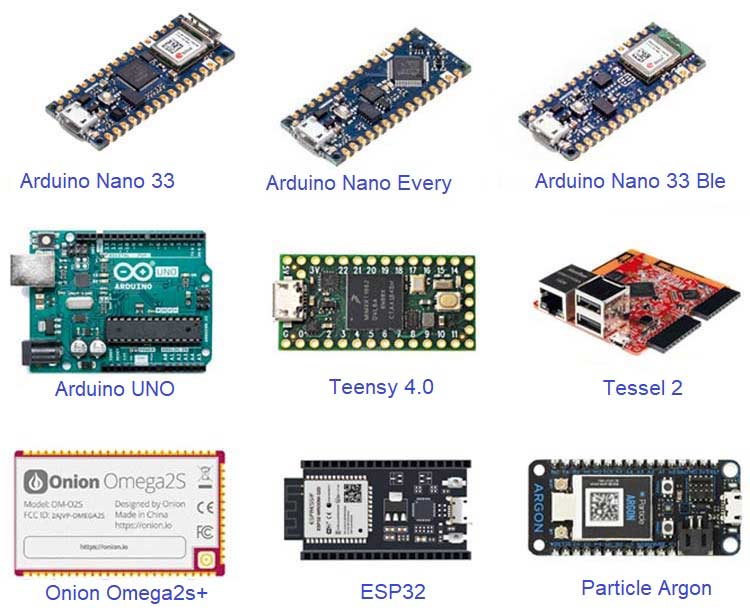
Microcontrollers are everywhere these days, if you look around your home, your car or work environment you will find them working silently under the hood and serving their purpose also because of the rapid development in the IoT industry the use of microcontrollers in our daily lives just got skyrocketed.
So, as 2019 comes to an end here is a quick list of the 10 most popular microcontrollers that disruptively changed the market flow and shown us the era of IoT.
Onion Omega2S+
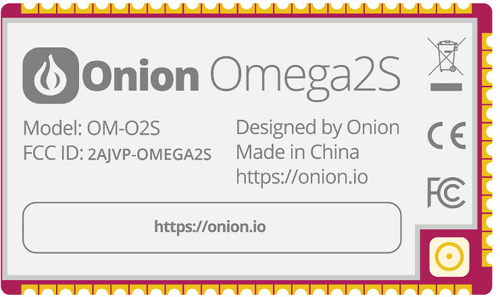
The Omega2 is Onion’s Linux-based, Wi-Fi enabled development board designed for makers of all skill levels to create build and connected hardware applications. Most interesting features listed below:
- 580MHz MIPS CPU
- 128MB Memory
- 32MB Storage
- USB 2.0 Support
- 3.3V Operating Voltage
- 12 GPIOs
- Dual-mode 2.4 GHz 802.11 b/g/n WiFi - simultaneously host a WiFi access point and connect to existing WiFi networks
- Runs OpenWRT 18.06 Linux operating system out of the box
- FCC and CE certified
It has a dimension of 34x20x2.8 mm which is less than 1/4 the size of the Raspberry Pi, and less than 1/3 the size of the Arduino Uno. The Omega2 comes with 64MB onboard flash storage with the firmware, that means just power on the board and you are good to go. All this just for $5.
Website: https://onion.io/
Datasheet/documentation: https://docs.onion.io/omega2-docs/
Adafruit Feather M0 Express
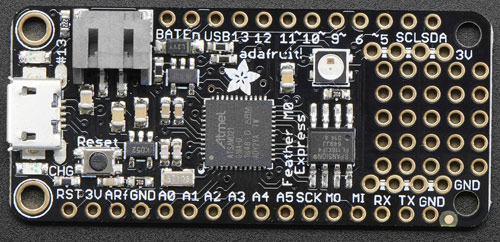
Adafruit Feather M0 Express is a very special development board that runs on CircuitPython!
CircuitPython is a beginner-oriented flavor of MicroPython - and as the name hints at, it's a small but full-featured version of the popular Python programming language specifically for use with circuitry and electronics. Most interesting features listed below.
- ATSAMD21G18 @ 48MHz with 3.3V logic/power
- 256KB of FLASH + 32KB of RAM
- No EEPROM
- 32.768 kHz crystal for clock generation & RTC
- 3.3V regulator with 500mA peak current output
- USB native support comes with USB bootloader and serial port debugging
- You also get tons of pins - 20 GPIO pins
- Hardware Serial, hardware I2C, hardware SPI support
- PWM outputs on all pins
- 6 x 12-bit analog inputs
- 1 x 10-bit analog output (DAC)
- Built-in 100mA Li-Po charger with charging status indicator LED
- Power/enable pin
- Measures 2.0" x 0.9" x 0.28" (51mm x 23mm x 8mm) without headers soldered in
When you plug it into your its shows up as a disk drive on your PC with the name CIRCUITPY, if you open the drive you will see some file one of which is “code.py” this is the file that CircuitPython triggers after boot if you edit this file and put your own code, the code will be executed immediately, no compilation or upload required. All this at a cost of $19.95.
Website: https://www.adafruit.com/product/3403
Datasheet/documentation:https://learn.adafruit.com/adafruit-feather-m0-express-designed-for-circuit-python-circuitpython?view=all
Particle Argon
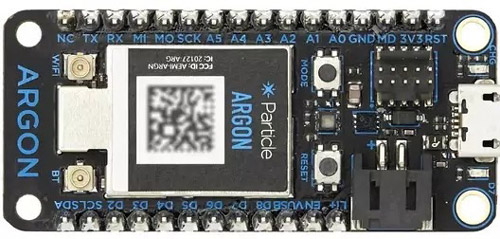
The Argon is a Wi-Fi enabled development board that can act as either a standalone Wi-Fi endpoint or Wi-Fi gateway or can be configured as Particle Mesh networks, it's powered by a Nordic nRF52840 chip and it has a built-in battery charging circuitry so it's easy to connect and charge a Li-Po for remote applications. Most interesting features listed below.
- Espressif ESP32-D0WD 2.4G Wi-Fi coprocessor
- Nordic Semiconductor nRF52840 SoC
- 20 mixed signal GPIO (6 x Analog, 8 x PWM), UART, I2C, SPI
- Micro USB 2.0 full speed (12 Mbps)
- Integrated Li-Po charging and battery connector
- JTAG (SWD) Connector
- RGB status LED
- Reset and Mode buttons
- On-board 2.4GHz PCB antenna for Thread/BLE (does not support Wi-Fi)
- Two U.FL connectors for external antennas (one for Thread/BLE, another for Wi-Fi)
- Mesh support with partial cloud
- FCC, CE, and IC certified
- RoHS compliant (lead-free)
Developers can also buy a variety of shields for interfacing with relays, motors, and the most important thing is that you can program it via Arduino Environment. All this at a cost of $27.00.
Website: https://www.particle.io/
Datasheet/documentation:https://docs.particle.io/argon/
PIC IoT WG
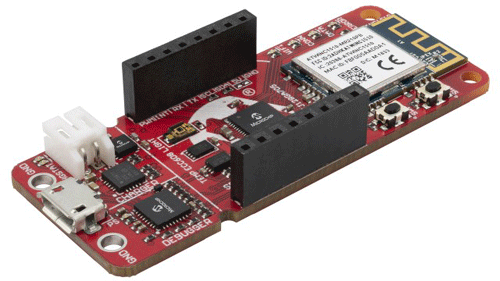
The PIC-IoT WG Development Board combines a powerful PIC24FJ128GA705 MCU, an ATECC608A CryptoAuthentication™ secure element IC and the fully-certified ATWINC1510 Wi-Fi® network controller - which provides the most simple and effective way to connect your embedded application to the Google Cloud IoT Core. The board also includes an on-board debugger and requires no external hardware to program and debug the MCU.
- PIC24FJ128GA705 microcontroller - 128 KB Flash Memory & 16 KB SRAM
- ATWINC1510 WiFi Module - Single-band 2.4GHz b/g/n IoT Network Controller
- ATECC608A CryptoAuthentication™ device protected Storage for 16 Keys, SHA256, AES-CCM, ECDH (Elliptic Curve Diffie-Hellman), ECDSA
- Other Board Features
- An RGB LED as a status indicator
- TEMT6000 Light sensor
- MCP9808 Temperature sensor
- mikroBUS header to interface to MikroElektronika click Boards™
- On-board Debugger
- Auto-ID for board identification in Microchip MPLAB X
- Programming and debugging
- Virtual COM port (CDC)
- One logic analyzer channel (DGI GPIO)
- Integrated Li-Ion/LiPo battery charger
Out of the box, the MCU comes preloaded with firmware that enables you to quickly connect and send data to the Google Cloud Platform using the on-board temperature and light sensors. All this at a cost of $28.65.
Website: https://www.microchip.com/developmenttools/ProductDetails/AC164164
Datasheet/documentation:http://ww1.microchip.com/downloads/en/DeviceDoc/PIC-IoT-WG-User-Guide-50002856A.pdf
Arduino Nano 33 IOT
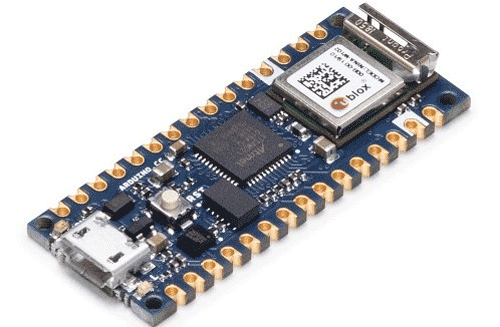
This small and powerful development board has Wi-Fi and Bluetooth connectivity, with its low power architecture that makes it a practical and cost-effective solution for your connected projects.
Arduino Nano 33 IoT is compatible with the Arduino IoT Cloud platform and supports full TLS secure transport: the ATECC608A crypto chip stores the cryptographic keys in hardware, offering a very high level of security for this class of products. The integration with the Arduino IoT Cloud offers also a very efficient way of setting up online dashboards with little coding and minimal effort. Most interesting features listed below
- This board is based on the SAMD21G18A
- Ublox ESP32 for Wi-Fi connection
- ARM® Cortex®-M0+ CPU running at up to 48 MHz
- 256 KB in-system self-programmable Flash
- 32 KB SRAM Memory
- 48 MHz Digital Frequency-Locked Loop (DFLL48M)
- 48 MHz to 96 MHz Fractional Digital Phase-Locked Loop (FDPLL96M)
- 12-channel Direct Memory Access Controller (DMAC)
- 12-channel Event System
- 32-bit Real Time Counter (RTC) with clock/calendar function
- CRC-32 generator
- One full-speed (12 Mbps) Universal Serial Bus (USB) 2.0 interface
- One two-channel Inter-IC Sound (I2S) interface
- One 12-bit, 350ksps Analog-to-Digital Converter (ADC)
- 10-bit, 350 ksps Digital-to-Analog Converter (DAC)
- Operating Voltage – 1.62V – 3.63
The board can either be used in a breadboard (when mounting pin headers) or as an SMT module, directly soldering it via the castellated pads. All this at a cost of $18.00.
Website: https://store.arduino.cc/usa/nano-33-iot
Datasheet/documentation:http://ww1.microchip.com/downloads/en/DeviceDoc/SAMD21-Family-DataSheet-DS40001882D.pdf
Arduino Nano Every
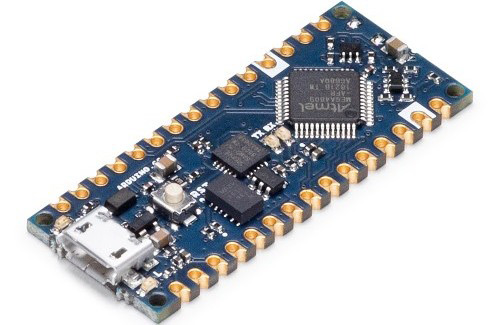
The Arduino Nano Every is Arduino’s 5V compatible board in the smallest available form factor: 45x18mm!
The Arduino Nano Every is an evolution of the traditional Arduino Nano board but features a lot more powerful processor, the ATMega4089. So, it is made to fulfill the requirements for the next generation. The small footprint and low price, make the Nano Every particularly suited for wearable inventions, low-cost robotics, electronic musical instruments, and general use to control smaller parts of a larger project. Most interesting features listed below
- The board is based on ATMega4809
- AVR® CPU
- 20 MHz low-power internal oscillator
- 48 KB In-system self-programmable Flash memory
- 256B EEPROM
- Up to 6 KB SRAM
- Single pin Unified Program Debug Interface
- Various sleep Options
- Five selectable internal voltage references: 0.55V, 1.1V, 1.5V, 2.5V, 4.3V
- One 10-bit 150 ksps Analog to Digital Converter
- 5 PWM Output
- External Input Voltage 21V - MAX
- Operating Voltage – 4.5V - 5.5V
This will allow you to make larger programs than with the Arduino Uno (it has 50% more program memory), and with a lot more variables (the RAM is 200% bigger). All this at a cost of $9.90.
Website:https://store.arduino.cc/usa/nano-every
Datasheet/documentation:https://content.arduino.cc/assets/Nano-Every_processor-48-pin-Data-Sheet-megaAVR-0-series-DS40002016B.pdf
Arduino Nano 33 BLE
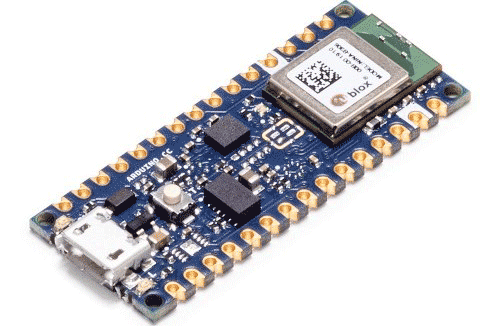
The Arduino Nano 33 BLE is a new board on a well-known form factor. It comes with an embedded 9 axis sensor that makes this board ideal for wearable devices,
The Arduino Nano 33 BLE is an upgrade of the traditional Arduino Nano but consists of a more powerful processor, the nRF52840 from Nordic Semiconductors, a 32-bit ARM® Cortex™-M4 CPU running at 64 MHz. Most interesting features listed below
- Bluetooth® 5, IEEE 802.15.4-2006, 2.4 GHz transceiver
- ARM® Cortex®-M4 32-bit processor with FPU, 64 MHz
- 1 MB flash and 256 kB RAM
- ARM® TrustZone® Cryptocell 310 security subsystem
- 128-bit AES/ECB/CCM/AAR co-processor (on-the-fly packet encryption)
- Nordic SoftDevice ready with support for concurrent multi-protocol
- Watchpoint and trace debug modules (DWT, ETM, and ITM)
- 12-bit, 200 ksps ADC - 8 configurable channels with programmable gain
- 15 level low-power comparator with wake-up from System OFFmode
- Audio peripherals: I2S, digital microphone interface (PDM)
- Temperature sensor
- Secure boot ready
- Secure erase
- Operating Voltage – 1.7V - 3.3V
- External Input Voltage 21V - MAX
The Nano 33 BLE comes with a 9 axis inertial measurement unit (IMU) which means that it includes an accelerometer, a gyroscope, and a magnetometer with a 3-axis resolution each. This makes the Nano 33 BLE the perfect choice for more advanced robotics experiments. All this at a cost of $19.00
Website: https://store.arduino.cc/usa/nano-33-ble
Datasheet/documentation: https://content.arduino.cc/assets/Nano_BLE_MCU-nRF52840_PS_v1.1.pdf
Arduino Nano 33 BLE Sense
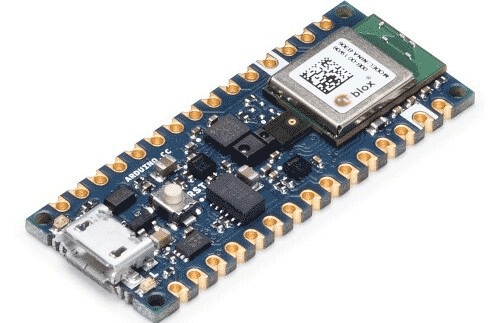
The Arduino nano 33 BLE sense board is very similar to The Arduino nano 33 BLE but the sense version of the board has five more sensors populated on the board. Most interesting features listed below
- LSM9DS1 - iNEMO inertial module: 3D accelerometer, 3D gyroscope, 3D magnetometer
- APDS9960 - Digital Proximity, Ambient Light, RGB and Gesture Sensor
- MP34DT05 - MEMS audio sensor omnidirectional digital microphone
- LPS22HB - MEMS nano pressure sensor: 260-1260 hPa
- HTS221 - Capacitive digital sensor for relative humidity and temperature
- Bluetooth® 5, IEEE 802.15.4-2006, 2.4 GHz transceiver
- ARM® Cortex®-M4 32-bit processor with FPU, 64 MHz
- 1 MB flash and 256 kB RAM
- ARM® TrustZone® Cryptocell 310 security subsystem
- 128-bit AES/ECB/CCM/AAR co-processor (on-the-fly packet encryption)
- Nordic SoftDevice ready with support for concurrent multi-protocol
- Watchpoint and trace debug modules (DWT, ETM, and ITM)
- 12-bit, 200 ksps ADC - 8 configurable channels with programmable gain
- 15 level low-power comparator with wake-up from System OFFmode
- Audio peripherals: I2S, digital microphone interface (PDM)
- Temperature sensor
- Secure boot ready
- Secure erase
- Operating Voltage – 1.7V - 3.3V
- External Input Voltage 21V - MAX
All this at a cost of $31.3
Website: https://store.arduino.cc/usa/nano-33-ble-sense
Datasheet/documentation: https://content.arduino.cc/assets/Nano_BLE_MCU-nRF52840_PS_v1.1.pdf
ESP32

ESP32-WROOM-32D and ESP32-WROOM-32U are powerful, generic Wi-Fi+BT+BLE MCU modules that target a wide variety of applications, ranging from low-power sensor networks to the most demanding tasks, such as voice encoding, music streaming, and MP3 decoding. Most interesting features listed below
- Xtensa®single-/dual-core 32-bit LX6 microprocessor(s), up to 600 MIPS (200 MIPS for ESP32-S0WD, 400MIPS for ESP32-D2WD)
- 448 KB ROM
- 520 KB SRAM
- 16 KB SRAM in RTC
- QSPI supports multiple flash/SRAM chip
- Wi-Fi - 802.11 n (2.4 GHz), up to 150 Mbps
- Compliant with Bluetooth v4.2 BR/EDR and BLE specifications
- +12 dBm transmitting power in BLE mode
- 34 × programmable GPIOs
- 12-bit SAR ADC up to 18 channels
- 2 × 8-bit DAC•10 × touch sensors•
- 4 × SPI
- 2 × I²S
- 2 × I²C
- 3 × UART
- 1 host (SD/eMMC/SDIO)•1 slave (SDIO/SPI)
- Ethernet MAC interface with dedicated DMA and IEEE 1588 support
- CAN 2.0
- IR (TX/RX)
- Motor PWM
- LED PWM up to 16 channels
- Hall sensor
All this at a cost of $14.03
Website: https://www.espressif.com/en/products/hardware/esp32/overview
Datasheet/documentation: https://www.espressif.com/sites/default/files/documentation/esp32_datasheet_en.pdf
ESP8266
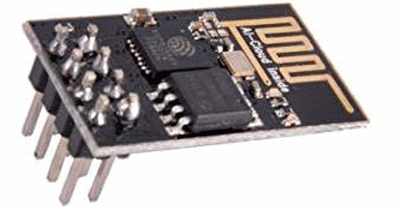
The ESP8266 WiFi Module is a self-contained SOC with integrated TCP/IP protocol stack that can give any microcontroller access to your WiFi network. The ESP8266 is capable of either hosting an application or offloading all Wi-Fi networking functions from another application processor. Each ESP8266 module comes pre-programmed with an AT command set firmware, meaning, you can simply hook this up to your Arduino device and get about as much WiFi-ability as a WiFi Shield offers (and that's just out of the box)! The ESP8266 module is an extremely cost-effective board with a huge, and ever-growing, community. Most interesting features listed below
- 2.4 GHz Wi-Fi (802.11 b/g/n, supporting WPA/WPA2),
- Tensilica L106 ultra-low-power 32-bit MCU running at 80 MHz (or, overclocked to 160 MHz)
- I²C serial communication protocol,
- Analog-to-digital conversion (10-bit ADC)
- Serial Peripheral Interface (SPI) serial communication protocol,
- I²S interfaces with DMA (Direct Memory Access) (sharing pins with GPIO),
- UART (on dedicated pins, plus a transmit-only UART can be enabled on GPIO2), and
- Pulse-width modulation (PWM).
The ESP8266 Wi-Fi module supports the standard IEEE802.11 b/g/n protocol, a complete TCP/IP protocol stack. Users can use this module to add networking capabilities to existing devices or to build separate network controllers. All this at a cost of $3.00
Website: https://www.espressif.com/en/products/hardware/esp8266ex/overview
Datasheet/documentation:https://www.espressif.com/sites/default/files/documentation/0a-esp8266ex_datasheet_en.pdf
Tessel 2
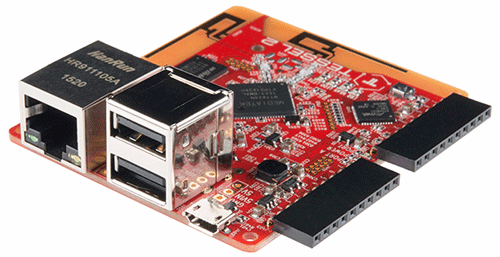
The Tessel 2 is an open-source development board. It runs JavaScript and supports npm, which means to control the board you need to know node.js. It's a platform for prototyping and producing embedded hardware, perfect for the Internet of Things (IoT) the primary processor of the Tessel 2 runs a very light version of OpenWRT.Most interesting features listed below
- A 580MHz WiFi router system on chip (Mediatek MT7620n) running Linux (OpenWRT)
- 64 MB of DDR2 RAM
- 32 MB of flash storage
- 16 GPIO
- 2 High-speed USB 2.0 ports
- a micro USB port
- A 10/100 Ethernet port (RJ-45 jack)
- A 48MHz ARM Cortex M0 microcontroller (Atmel SAMD21)
- Two module ports that are much more capable than their predecessors
- a button and a bunch of LEDs, because what’s a Tessel without blinky?
All this at a cost of $44.45
Website: https://tessel.io/
Datasheet/documentation: https://tessel.gitbooks.io/t2-docs/content/
Teensy 4.0
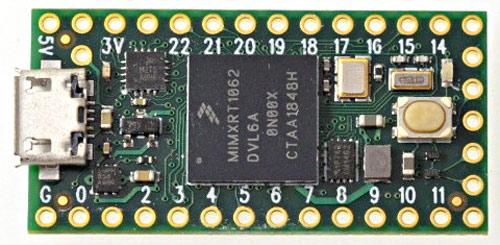
Smallest form factor with the most powerful processor from the company, Teensy 4.0 is the latest Teensy, offering the fastest microcontroller and powerful peripherals in the Teensy 1.4 by 0.7-inch form factor. Teensy 4.0 is the same size and shape as Teensy 3.2 and retains compatibility with most of the pin functions on Teensy 3.2. Most interesting features listed below
- ARM Cortex-M7 at 600 MHz
- 1024K RAM (512K is tightly coupled)
- 2048K Flash (64K reserved for recovery & EEPROM emulation)
- 2 USB ports, both 480 MBit/sec
- 3 CAN Bus (1 with CAN FD)
- 2 I2S Digital Audio
- 1 S/PDIF Digital Audio
- 1 SDIO (4 bit) native SD
- 3 SPI, all with 16 words FIFO
- 3 I2C, all with 4 byte FIFO
- 7 Serial, all with 4 byte FIFO
- 32 general-purpose DMA channels
- 31 PWM pins
- 40 digital pins, all interrupt capable
- 14 analog pins, 2 ADCs on chip
- Cryptographic Acceleration
- Random Number Generator
- RTC for date/time
- Programmable FlexIO
- Pixel Processing Pipeline
- Peripheral cross triggering
- Power On/Off management
All this at a cost of $19.95
Website: https://www.pjrc.com/store/teensy40.html
Datasheet/documentation: https://docs.platformio.org/en/latest/platforms/teensy.html
Raspberry Pi 4 Model - B
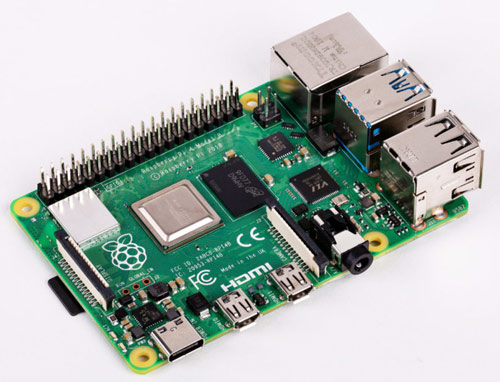
A super cool $35 proccing powerhouse in a credit card size form factor, straight from the UK by the Raspberry Pi Foundation to promote the basic computer science in schools and developing countries. It runs on raspbian A Debian-based computer operating system created for the Raspberry Pi. Most interesting features listed below
- Broadcom BCM2711, Quad core Cortex-A72 (ARM v8) 64-bit SoC @ 1.5GHz
- 1GB, 2GB or 4GB LPDDR4-3200 SDRAM (depending on model)
- 2.4 GHz and 5.0 GHz IEEE 802.11ac wireless, Bluetooth 5.0, BLE
- Gigabit Ethernet
- 2 USB 3.0 ports; 2 USB 2.0 ports.
- Raspberry Pi standard 40 pin GPIO header (fully backward compatible with previous boards)
- 2 × micro-HDMI ports (up to 4kp60 supported)
- 2-lane MIPI DSI display port
- 2-lane MIPI CSI camera port
- 4-pole stereo audio and composite video port
- H.265 (4kp60 decode), H264 (1080p60 decode, 1080p30 encode)
- OpenGL ES 3.0 graphics
- Micro-SD card slot for loading operating system and data storage
- 5V DC via USB-C connector (minimum 3A*)
- 5V DC via GPIO header (minimum 3A*)
- Power over Ethernet (PoE) enabled (requires separate PoE HAT)
- Operating temperature: 0 – 50 degrees C ambient
Website :https://www.raspberrypi.org/products/raspberry-pi-4-model-b/
Datasheet/documentation: https://www.raspberrypi.org/documentation/
Azure Sphere MT3620 Starter Kit
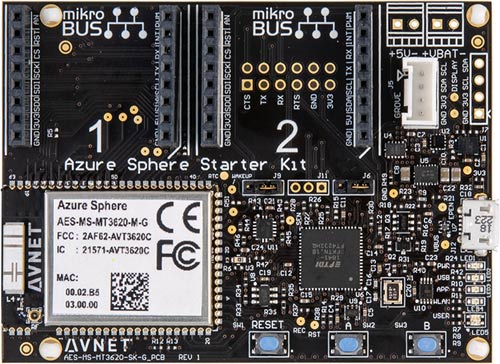
The Avnet Azure Sphere MT3620 Starter Kit supports rapid prototyping of highly secure, end-to-end IoT implementations using Microsoft’s Azure Sphere. The small form-factor carrier board includes a production-ready MT3620 Sphere module with Wi-Fi connectivity, along with multiple expansion interfaces for easy integration of sensors, displays, motors, relays, and more. Most interesting features listed below
Carrier Board
• Two MikroE Click board expansion sockets
• Grove expansion connector (I2C)
• On-board sensors
– 3-Axis accelerometer
– 3-Axis gyro
– Temperature
– Pressure/Barometric
– Ambient Light
• Interface for optional OLED 128x64 display
• USB Interface
– Supports debug, service & recovery UARTs, and JTAG
• User pushbutton switches and LEDs
• 5V to 3.3V Power regulation
• DC Supply Input:
– USB 5V from the host computer
– Terminal footprints for external 5V DC and VBAT supplies
Azure Sphere MT3620 Module
- MT3620AN SoC
- 3x ISU interfaces pre-configured for UART, SPI, I2C
- ADC/GPIO: 3x 12-bit ADC inputs (or 3 GPIOs)
- PWM/GPIO: 9x PWM outputs (or up to 24 GPIOs)
- RTC (requires VBAT supply)
- Dual-band 2.4/5GHz 802.11 a/b/g/n Wi-Fi
- Dual-band 2.4/5GHz chip antenna
All this at a cost of $75.07
Datasheet/documentation:https://www.avnet.com/shop/us/products/avnet-engineering-services/aes-ms-mt3620-sk-g-3074457345636825680/
Arduino UNO

In my opinion, Arduino Uno remains to be the top favorite of absolute beginners and hobbyists. Arduino Uno R3 is the simplest yet most powerful prototyping environment. It is based on the ATmega328P chip. Most interesting features listed below
- Microcontroller: ATmega328
- Operating Voltage: 5V
- Input Voltage (recommended): 7-12V
- Input Voltage (limits): 6-20V
- Digital I/O Pins: 14 (of which 6 provide PWM output)
- Analog Input Pins: 6
- DC Current per I/O Pin: 40 mA
- DC Current for 3.3V Pin: 50 mA
- Flash Memory: 32 KB of which 0.5 KB used by bootloader
- SRAM: 2 KB (ATmega328)
- EEPROM: 1 KB (ATmega328)
- Clock Speed: 16 MHz
This features a rich development board for beginners just cost around $18.50
Website: https://store.arduino.cc/usa/arduino-uno-rev3
Datasheet/documentation: https://store.arduino.cc/usa/arduino-uno-rev3









